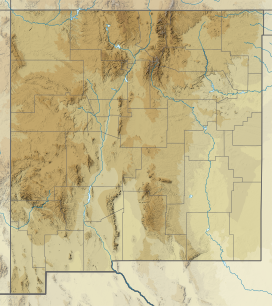The Tusas Mountains are a mountain range in northern New Mexico, extending slightly into southern Colorado. They are considered the southeasternmost part of the San Juan Mountains.[1] Grouse Mesa, 11,407 feet (3,477 m),[3] is the highest peak in the range.[1] The mountains are located to the west of Taos and northwest of Santa Fe. The Tusas Mountains are a wide region of upland mesas and gently sloping mountains, dissected in places by deep canyons.[4]
| Tusas Mountains | |
|---|---|
 Brazos Cliffs and Valley, New Mexico | |
| Highest point | |
| Peak | 11,407 ft (3,477 m), Grouse Mesa[1] |
| Dimensions | |
| Length | 67 mi (108 km) north-south |
| Width | 59 mi (95 km) east-west |
| Area | 2,709 sq mi (7,020 km2) |
| Geography | |
| Country | United States |
| State | New Mexico |
| Range coordinates | 36°28′47″N 106°15′06″W / 36.47972°N 106.25167°W[2] |
Geography edit
The eastern part of the range is primarily located in the Carson National Forest, bordered by the Taos Plateau volcanic field and Rio Grande del Norte National Monument to the east. It provides the headwaters for the Rio San Antonio, a tributary of the Conejos River (which flows into the Rio Grande in Colorado), and further south the Rio Tusas and Rio Vallecito, which form the Rio Ojo Caliente, a tributary of the Rio Chama (also a Rio Grande tributary). Numerous volcanic features are located along the eastern edge of the range bordering the Taos plateau[5] including nearby San Antonio Mountain.
Much of the western part of the range, also known as the Brazos Mountains, is in the privately owned Tierra Amarilla Land Grant. The terrain consists of harder granite and metamorphic rock, and is more rugged than the eastern side.[5] It includes features such as the Brazos Cliffs and several small mountain lakes including Hidden Lake and Sugar Loaf Lake. It is drained primarily by the Rio Chama and its tributary the Rio Brazos.
Climate edit
Grouse Mesa, the highest peak in the Tusas Mountains, has a subalpine climate (Köppen Dfc).
| Climate data for Grouse Mesa 36.8343 N, 106.3989 W, Elevation: 11,198 ft (3,413 m) (1991–2020 normals) | |||||||||||||
|---|---|---|---|---|---|---|---|---|---|---|---|---|---|
| Month | Jan | Feb | Mar | Apr | May | Jun | Jul | Aug | Sep | Oct | Nov | Dec | Year |
| Mean daily maximum °F (°C) | 29.3 (−1.5) |
30.4 (−0.9) |
37.0 (2.8) |
43.1 (6.2) |
51.9 (11.1) |
63.4 (17.4) |
67.4 (19.7) |
65.1 (18.4) |
59.1 (15.1) |
49.0 (9.4) |
36.5 (2.5) |
29.2 (−1.6) |
46.8 (8.2) |
| Daily mean °F (°C) | 18.6 (−7.4) |
19.4 (−7.0) |
25.1 (−3.8) |
30.8 (−0.7) |
39.6 (4.2) |
50.0 (10.0) |
54.5 (12.5) |
52.8 (11.6) |
47.0 (8.3) |
37.3 (2.9) |
26.0 (−3.3) |
18.8 (−7.3) |
35.0 (1.7) |
| Mean daily minimum °F (°C) | 7.8 (−13.4) |
8.4 (−13.1) |
13.2 (−10.4) |
18.4 (−7.6) |
27.3 (−2.6) |
36.5 (2.5) |
41.5 (5.3) |
40.4 (4.7) |
34.9 (1.6) |
25.7 (−3.5) |
15.4 (−9.2) |
8.5 (−13.1) |
23.2 (−4.9) |
| Average precipitation inches (mm) | 4.61 (117) |
4.75 (121) |
4.53 (115) |
3.20 (81) |
2.41 (61) |
0.86 (22) |
2.41 (61) |
3.35 (85) |
2.84 (72) |
3.03 (77) |
3.51 (89) |
4.53 (115) |
40.03 (1,016) |
| Source: PRISM Climate Group[6] | |||||||||||||
History edit
Gold and silver were discovered in the Tusas in 1881, but the deposits were of low quality and the area never saw significant mining activity.[7]
In 1986 the United States Board on Geographic Names redefined the Brazos Mountains, originally considered a separate mountain range, as part of the Tusas Mountains, although the old name is still locally used.[7]
Highest peaks edit
| Rank | Name | Elevation | Prominence | Coordinates |
|---|---|---|---|---|
| 1 | Grouse Mesa[3] | 11,407 ft (3,476 m) |
1,365 ft (416 m) |
36°49′53″N 106°24′27″W / 36.83139°N 106.40750°W |
| 2 | Brazos Peak[8] | 11,286 ft (3,440 m) |
498 ft (151 m) |
36°48′31″N 106°22′56″W / 36.80861°N 106.38222°W |
| 3 | Unnamed peak | 11,060 ft (3,371 m) |
840 ft (256 m) |
|
| 4 | Unnamed peak | 10,977 ft (3,345 m) |
357 ft (109 m) |
|
| 5 | Brazos Ridge[9] | 10,745 ft (3,275 m) |
580 ft (177 m) |
36°55′32″N 106°21′27″W / 36.92556°N 106.35750°W |
References edit
- ^ a b c "Tusas Mountains". Peakbagger. Retrieved 2019-09-21.
- ^ "Tusas Mountains". Geographic Names Information System. United States Geological Survey, United States Department of the Interior. 2011-12-13. Retrieved 2019-09-21.
- ^ a b "Grouse Mesa". Geographic Names Information System. United States Geological Survey, United States Department of the Interior. 1980-11-13. Retrieved 2019-09-21.
- ^ Julyan 2006, p. 69–70.
- ^ a b Julyan 2006, p. 70.
- ^ "PRISM Climate Group, Oregon State University". PRISM Climate Group, Oregon State University. Retrieved October 2, 2023.
To find the table data on the PRISM website, start by clicking Coordinates (under Location); copy Latitude and Longitude figures from top of table; click Zoom to location; click Precipitation, Minimum temp, Mean temp, Maximum temp; click 30-year normals, 1991-2020; click 800m; click Retrieve Time Series button.
- ^ a b Julyan 2006, p. 73.
- ^ "Brazos Peak". Geographic Names Information System. United States Geological Survey, United States Department of the Interior. 1980-11-13. Retrieved 2019-09-21.
- ^ "Brazos Ridge". Geographic Names Information System. United States Geological Survey, United States Department of the Interior. 2011-06-11. Retrieved 2019-09-21.
Works cited edit
- Julyan, Robert (2006). The Mountains of New Mexico. UNM Press. ISBN 0-82633-516-0.
